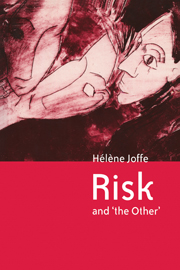Book contents
- Frontmatter
- Contents
- Preface
- Acknowledgements
- 1 Responses to risks: an introduction
- 2 Human responses to risks: ‘not me’, ‘the other is to blame’
- 3 A study of lay people's responses to a risk: HIV/AIDS in Britain and South Africa
- 4 Evaluating two social psychological models of the response to risks
- 5 The source of linking risk and ‘the other’: splitting objects into ‘good’ and ‘bad’
- 6 Social representations of risks
- 7 Emotional life: a new frontier for social theory
- 8 Changing social representations of risks
- References
- Index
4 - Evaluating two social psychological models of the response to risks
Published online by Cambridge University Press: 22 September 2009
- Frontmatter
- Contents
- Preface
- Acknowledgements
- 1 Responses to risks: an introduction
- 2 Human responses to risks: ‘not me’, ‘the other is to blame’
- 3 A study of lay people's responses to a risk: HIV/AIDS in Britain and South Africa
- 4 Evaluating two social psychological models of the response to risks
- 5 The source of linking risk and ‘the other’: splitting objects into ‘good’ and ‘bad’
- 6 Social representations of risks
- 7 Emotional life: a new frontier for social theory
- 8 Changing social representations of risks
- References
- Index
Summary
The concept of risk perception emerged from work carried out in the 1950s by health service psychologists in the United States. They were interested in how people think about the health and safety risks they face. Their goal was to forge predictive models concerning health-related behaviour. These models have the perceived risk of becoming ill or perceived vulnerability to illness as a central feature. Research on this variable gained considerable impetus in the 1980s when Weinstein and his colleagues discovered that the majority of people are ‘unrealistically optimistic’ in relation to a large range of health and safety risks. While early disaster work was concerned with the role of unconscious defensiveness in responses to mass threats, by the 1980s the focus on the unconscious had been cognitivised, and denial had been conceptualised as ‘optimistic bias’ (OB). This chapter focuses on research conducted within the cognitive psychological rubric, including both OB and the older field of attribution theory. This work is evaluated, with an eye to discerning the assumptions it makes.
Theorising the response to crisis in mainstream social psychology
Optimistic bias: comparative risk judgements and the ‘not me’ phenomenon
The OB framework demonstrates that humans tend to respond self-protectively when asked to assess their risk of being affected by a potential hazard. They imagine, unrealistically, that the future holds few adverse events (Taylor, 1989) and expect such events to strike others, rather than themselves (Weinstein, 1982).
- Type
- Chapter
- Information
- Risk and 'The Other' , pp. 56 - 72Publisher: Cambridge University PressPrint publication year: 1999

